Pioneer Trail

Mabukuwene Nature Reserve Fridays 19:00 - 21:00 hrs | Norman Scott Norman's Email address |
With thanks to the publishing team:-
Mrs Helen Rorke, Mr Graham Ralphs, Mrs Karen FitzPatrick, Leon Wuyts
In writing my articles for our magazine, I am always surprised at what the troop has achieved during the previous four months, when the last magazine was published. For our readers not living in Zimbabwe, you will not appreciate the problems our country is currently experiencing and so the above statement will not mean anything to you. I have no intention of describing what we have to endure in the way of shortages and costs, for to think negatively will not help in the slightest. As you read on, you may get some idea, but the message I am trying to put across, is that Scouting is playing a vital part in the character building of our members. When one has one's "back to the wall," one really has to think in order to survive, one has to be innovative, to use one's initiative in all spheres of life and above all to believe and trust in God, our creator. In reading the Scouts' accounts of their activities, I feel that they are looking at life in a positive light, treasuring the good memories and accepting what they cannot change. Oh, for the privilege of youth.
In writing about our monthly hikes in this issue, our scouts have conveyed their enjoyment at being out in the veld, (bush). Away from the city, the hustle and bustle of their daily lives, yes, even their parents. This time, spent together with their peers, having to cook their own food, carry their own kit and discipline themselves into walking over some rather rugged terrain that the Matopos Hills has to offer, is indeed character building. Whether it is hot or cold, wet or dry, we go hiking and the Scouts love it. The night camp is of special importance, of value and of camaraderie. The setting up of camp, cooking the evening meal and then gathering around the fire to sip hot chocolate or coffee and chat and laugh unrestrained, is really great to experience and indeed, stimulating, relaxing. The hikes are the anchor activity of our Troop. They are kept short, between 15 and 20 kilometres, are routed across country using maps to pass through places of scenic beauty and / or of historic interest. With a pack on one’s back, carrying sleeping bag, cooking utensils and food, there is enough physical exertion to ensure that by the time the destination is arrived at, the feet are a little tired, the shoulders beginning to ache and the body becoming weary.
That these hikes continue to take place at all with our fuel crisis at its peak is quite amazing. Not only is fuel in critically short supply, but many other essential items, which result in inflated prices. Our hiking equipment is old, second and third ownership and in many instances of heavy manufacture with no lightweight high-energy foods. Enough water for drinking and cooking has to be carried, for once again we are suffering a drought year and what water is in the rivers is infested with the bilharzia parasite. But we go on!
The other activities we participate in, such as competitions and camps with other troops also present us with many challenges beside that of the competition itself. However, these challenges must not be seen as obstacles but rather as the building blocks upon which the individual characters are moulded.
Adding to our problems and which strike us emotionally the most, is that we are losing members whose families are emigrating. Within the space of six weeks, July to September, the troop bade farewell to five of our Scouts. First to go was Thomas Timberlake whose family left for England. Then Timothy and David Chadwick left for Canada, followed a few weeks later by Edwin, John C and Matthew (our Troop mascot) Swannack, to Canada. To these Scouts I pass my good wishes and farewell. Make the most of the opportunities that lie ahead for you for, "With all its sham, drudgery and broken dreams, it is still a beautiful world."
But not all is sad news. For the third successive year the Troop won the William Arnold Carnegie Assegai Competition. This is the most prestigious Competition in the Province of Matabeleland and to win it requires a broad range of Scouting skills. My congratulations to Assistant Patrol Leader Timothy Chadwick, Assistant Patrol Leader Edwin Swannack, Kieran FitzPatrick, Christopher MacKenzie, David Chadwick and John C Swannack for retaining the Assegai in the Troop. Our Patrol was one hundred and twenty points ahead of the Patrol that came second.
Click to enlarge: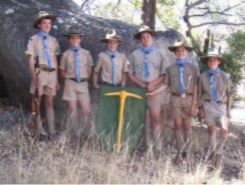 "Assegai Patrol Timothy (holding the Assegai), Kieran, Christopher, Edwin, John-C and David |
Just prior to leaving, Edwin Swannack gained his Adventure Standard and because he had been acting as Patrol Leader of his Patrol for several months, he was promoted to Patrol Leader of Eagle Patrol. Well-done Edwin. It is the Troop’s loss that you will be leaving us so soon but I am sure you will find a Troop in Canada to continue with your Scouting.
Joining the Troop is Leon Wuyts. Leon joins Scouting as a Senior so he will be "fast-tracked" through the syllabus in order to be of assistance in running the Troop in as short a time as possible. Welcome Leon, I am sure you will enjoy what Scouting has to offer and all the best for your "O" level examinations that you will be writing shortly.
Click to enlarge: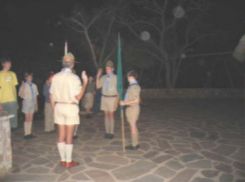 Edwin Swannack reaffirms his Scout Promise on being promoted to Patrol Leader of Eagle Patrol at our Troop meeting, Mabukuwene, 26 September 2005 |
 And now it is back to my favourite Pseudolachnostylis Maprouneifolia, with my floppy hat pulled over my eyes as I dream of a line of young men waiting to join the Troop to fill the gaps of those who have left.
And now it is back to my favourite Pseudolachnostylis Maprouneifolia, with my floppy hat pulled over my eyes as I dream of a line of young men waiting to join the Troop to fill the gaps of those who have left.N. Scott
Scout Leader

MADZI HIKE
6th - 7th May 2005
It had been a lovely warm day, when we all assembled at Christ the King Church. It was quite a small gathering of Chris, Scott, Edwin, Ed, Tom and John C my brother and myself. The Swannacks were a bit late so we got off to a late start but Norm put the pedal to the metal and lost time was regained. When we got to the National Park entrance and the turning point to Sandyspruit Dam, Norm got out to chat to the warden about staying the night as Sandyspruit, but unfortunately he was declined so we carried onto Gordon Park.
At Gordon Park we made our supper and ate leisurely whilst talking about rugby and anything else that came to mind. After supper, we laid out our sleeping bags on the floor, and John-C and Scott took some mattresses from the ‘crew hut’ and made a decent bed in the donkey-cart.
We then switched the generator off, so that we could play a decent game of "Raven’s Hill". When we were all tired we snuggled into our beds and then after about half an hour we were all .com.
Click to enlarge: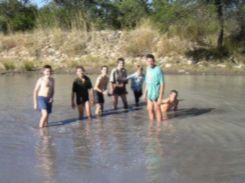 "Mud, mud, glorious mud" Water + Scouts = Mud fight! Here John-C, Scott, David, Tim, Christopher, Edwin and Tom paddle innocently in the dawn before all hell breaks loose! |
Timothy Chadwick
Assistant Patrol Leader
The Miraculous Phenomenon
Sunday 8th May 2005
It was my turn to take the Monthly service at Gordon (Scout) Park. It had come again. These days are always a great joy and privilege for me. It was May 8th, Ascension Sunday, the ascending of Christ into Heaven after He had fulfilled His earthly mission.
After a pleasant drive to the Park with the FitzPatrick family, I began the sacred Ceremony at 12:00 noon in St George’s (open air) Chapel. It was a brilliant day with not a cloud in the sky, with just the deep blue vault of heaven above, the trees and the superb rock formations enclosing the chapel area.
The introduction and the readings having been read, I began to say a few words about the contents of the lessons from the Old and New Testaments, concerning the Ascension.
As said above, there was not the slightest sign of a cloud in the whole wide sky when the service had commenced. In the middle of the Homily I happened to look up and behold, out of nowhere, there was a very distinct figure of Christ in the form of a very clear and well-defined cloud - showing the human figure with head and outstretched arms and feet in a flowing beautiful gown. Words first failed me. But when I had recovered my speech I drew the attention of all present to this incredible phenomenon. They all saw it and were aghast, we had hardly looked when the cloud broke up and the whole sky was blue once more.
Click to enlarge: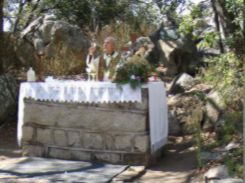 Father Odilo celebrating Mass in the St. George’s Chapel, Gordon Park, on Ascension Sunday, 8 May 2005. The dry flower arrangement was done by Scouts, Christopher and David |
Fr. Odilo Weeger
Nanke Cave Hike
3rd - 4th June 2005
It was a hot, stuffy evening; we all met at 6 o’clock at the 8th Hillside Scout Hall. When I arrived there was a whole hoard of scouts waiting for the hike. Norm was in a meeting so we ran around wildly releasing some of the energy built up during the week, while we waited for him.
At long last Norm arrived and told us that we would be hiking around the Toghwana Dam area. Tim, David and I, being the only ones who knew the area, were delighted. It is a lovely area.
Click to enlarge: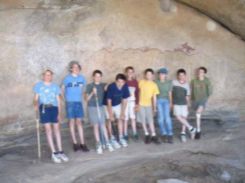 Dwarfed by the magnificent Bushman paintings high up on the walls of Nanke Cave are Scouts Tom, Connor, Edwin, Dylan, Kieran, Tim, John-C, Scott and David. |
Once we had sufficiently warmed up we all piled into Norm’s landie (actually on the trailer) and set off. We rattled along bumpy dirt roads, through riverbeds and over rocks until we reached a kraal where we parked the car under an enormous shady Marula tree. It was from here that we started our hike.
Click to enlarge: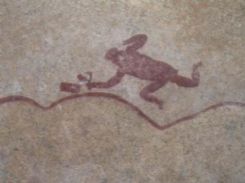 An unusual Bushman painting of a man running/falling over the "hills" in Maholoholo Cave, Matopos |
We stopped here for a short break. The paintings were unusual and very clear. We now came down the hill, into the valley and then up the steep slope of the next hill. We trundled through a grassy plain, until we reached the next hill, which was Nanke.
Click to enlarge: Bushman painting of a Giraffe, Nanke Cave, Matopos |
From here Norm went back to get the car and the rest of us proceeded on the scenic walk to Toghwana Dam. On the way we stopped at a stream and filtered water through our hats into our water bottles, as we did not have much left. We also stopped at a smelting site, where there was an old clay furnace still remaining from the early Makalanga people who used it to smelt iron ore, some 150 years ago. We eventually reached Toghwana dam, where we found Norm waiting for us.
We then climbed into the trailer again and bounced along the rough road to Gordon Park. We had lunch and then messed around for the rest of the afternoon. We arrived back in Bulawayo at 5:30 pm. A short, enjoyable hike in a most beautiful area.
Thomas Timberlake
Notes on Makalanga Iron Smelting
In March, 1965, having spent eight years in the Matopos National Park and having seen a number of iron smelting furnaces, I decided to make notes on the manner in which the Makalanga and Abenyubi carried out this procedure.
Amongst others, information was gathered from several Africans, ranging in age from 80 to 90 years. They had all been either actively engaged in or closely connected with the iron industry. Two had built and operated their own furnaces, and one over 90 years, stated that he could build another.
The Makalanga in the Matopos Hills have long been associated with iron smelting and the making of metal hoes and weapons, which were traded with the various tribes outside the hills. This was particularly the case with the Matabele nation, after their arrival in Rhodesia in 1838.
Apparently each community or related group of kraals would have one or more smiths, who looked after the requirements of that community, and bartered items over and above the needs for
other necessities of life. Anybody could become a smith provided he had sufficient interest and this occupation was not a reserved one or a jealously guarded trade. Often enough the person who required a metal hoe or other instrument would go and fetch the iron stone from distant deposits and bring it to the smith. It was carried in baskets by both men and women and was also transported on the backs of oxen.
Again, often enough the person requiring the item might be asked to assist in its manufacture from beginning to end. Women and children could be present and there was apparently no custom which forbade this. The Makalanga did not usually mould their furnaces with breasts, and the only one known to me is that south of Toghwana which is protected by the Commission for the Preservation of Natural and Historical Monuments and Relics and where breasts are portrayed. Often a wife would help her husband pumping the bellows.
Furnace sites in evidence today are invariably situated in secluded corners of kopjes or behind a group of rocks, though a few are to be found on the edges of vleis. Whilst this no doubt provided a certain amount of security for a valuable commodity, it was also necessary to keep the furnaces out of draughts. They are often actually situated under rocky overhangs, many of which were obviously gaily decorated with “Bushman” paintings at one time, but have since become coated with smoke to such an extent that the paintings have been impaired or, in some cases, completely obliterated, by this latter occupation. There is usually a dwala or flat rock in the immediate vicinity which bears signs of slag and one such site had a mortar about 6 in. deep in the solid granite dwala, no doubt used with a pestle for breaking down iron stone ore (north of Toghwana Dam).
In order to construct an imVuto or furnace, one started with the Zhamba or Dumba which is the body of the furnace. This was made of good clay and could not be done in one day, as it had to harden as it went along. A requirement involved the scooping out of a small hole the size of a cup in the ground immediately under the furnace, into which some muti was placed and the hole covered over again. An opening was left at the back for the bellow pipes and this was known as Mulomo we zhamaba; similarly an opening was left in the front from which the iron sponge and charcoal was raked, and this was called Mukoba we zhamba.
There was a hole in the top from which the smoke and fumes escaped by means of which it was possible to introduce the charcoal and iron ore into the furnace. This went under the name of Bila, and this completed the body of the furnace.
Each furnace was provided with two bellows known as imVuto and from each bellows there was a clay pipe known as muhuliti wemvuto and the ends of these pipes were so placed that they pointed straight into another larger pipe known as muhamato wemvuto or nyengo yemvuto. This latter pipe ensured, with bellows being operated alternatively, a constant stream of air being directed into the furnace at one point, via the mulomo we zhamba.
These clay pipes were made by wrapping clay around a smooth stick of correct circumference and removing the stick whilst the stick was still wet. The clay then dried into ready-made pipes.
The bellows were invariably made out of goatskins, as follows: - A young goat would be selected in the evening and would be made to drink a concoction of muti provided by the local doctor or nyanga. The next morning early, the goat would be taken and hung with a rein by the neck to a tree. The skin would then be cut right round the neck and process of skinning the animal alive
commenced. The more bleating the animal made, the better the bellows. With the aid of a small stick, the skin and meat would be prodded and the skin eased off the body towards the back quarters. When the front legs were reached, the skin was cut at the knees and again at the hocks on the hindquarters and eventually the whole skin came off with the hair on the inside.
The skin must now be softened whilst it is still fresh and this was done by rubbing it against the rough bark of trees, liberally applying cow manure and by rubbing in the hands. When soft and pliable, the skin was again turned inside out with the hair on the outside. The two forelegs were turned inwards and were tied and these shrunk so as to seal off the two vents created by the leg bones. (All informants stressed this point.) The right hand bellows will have the right hand back leg tied with a thong, and the right hand clay pipe muhuliti tied into the left leg vent. In other words, the goatskin is upright when in use, and sitting on its posterior with its stomach facing the furnace.
The same takes place with the left hand bellows with the pipe in the right leg and the muhuliti pipes as close to each other, on either side of the operator. The neck orifice acts as the inlet valve and is uppermost. Two small sticks are placed on either side of the orifice and by means of thongs and the use of the thumb through a thong on one side and the last three fingers of the hand on the other side through another thong, this opening can be opened and closed at will. Index fingers were not used. As the unclenched hand raised the bellows, the air rushes in and on the descent the hand is closed, forcing the air through the muhuliti pipes into the Mulomo we zhamba via the muhamato pipe. Bellows were worked alternatively with a rhythmic movement, accompanied by humming or singing.
The bellows operator sat on a seat known as Tulo (Chigalo, Ibge) and this was usually a stone. It could also be made of mud and was suited just right for the administration of the bellows. To save this person from undue heat and to provide better protection against draughts, two wings were added to the main body or Zhamba, and these were known as muhawa we mhepo or siDziba mhepo. These were, in the Matopos, made from slabs of rock stuck into the ground at the correct angle, as this commodity is to be found on all sides.
This then, is the first stage and after passing through this point, the iron ore is on the sponge stage. From there it is further treated in another furnace known as Chido, which will be described later.
The iron stone ore, before being put into the furnace, would be taken to the nearby dwala or flat rock and would be pounded with a rock hammer known as nYondo until it had broken up into reasonably small pieces.
Good quality charcoal was essential, and the trees best suited for this purpose were the Bukea africana (umNondo) and the Terminalias (iMangwe or Mususu) in that order. This was prepared in two ways:
i. By setting fire to a stump at night time and allowing it to burn very hot, in the absence of wind, and then throwing cold water onto it before the stump was completely burnt out;
ii. By doing the same as above but instead of throwing water on it, throwing soil onto it and leaving it to cool for two days, without access to the atmosphere. This charcoal was known as maSimbe.
To start smelting, a fire was lit in the furnace by the use of charcoal mainly and this was brought
up to a high temperature by means of the bellows. The crushed ore was then inserted into the fire through the Bila or chimney and further charcoal added and more iron ore in layers. This iron ore was known as Mankula (Hayi tongu iva imbisi - Mankula ya Fuba.)
As the iron ore melted, the metal would drip through the charcoal onto the floor of the furnace, and after a mornings work, the furnace would be raked out and the ashes, slag and metal sponge taken onto the rock or dwala. Here it was sorted out and the metal placed on one side and the slag on another. The metal sponge was known at this stage as Tale and the slag was called Zhaya or Manyele. Tongs were used and these were known as Dhlawo or ChiBato.
The slag or Zhaya was used as a flux and this was ground up into a fine powder and kept on one side for future use in the Chido furnace.
This latter comprised of the same type of bellows and pipes, and the furnace was a small, open one, with only a fairly low mud wall protecting the bellows operator. Sufficient sponge was taken to ensure metal was available for the required item of manufacture. Sometimes a large piece of sponge would be cut in half, if it was too much of an item such as an assegai head. Here the sponge was brought up to a white heat and this turned it into more of a metal lump than a sponge.
The white hot metal was taken out with the tongs DhlawoI and to take it out was to ku dusa. The bellows man would then rest until he was further required and two other men, the smith and the hammer man took over. The smith would hold the white-hot metal in his tongs and with a small stick in his other hand he would point out exactly where he wanted the hammer man to strike. The anvil was a rock of a hard nature known as nYondo or chiFulo, or just Chido or Chido dukwana for a small hammer. There were various sizes for various requirements, and the hammer man stood in a hole, up to his waist, at the side of the anvil which gave him greater accuracy and comfort.
The smith would sing a little ditty, indicating each time with his stick where he wanted the metal struck and which what force and gradually the metal would become elongated and take shape. If it cooled down too much, it was returned to the red-hot charcoal fire and the bellows man became active again. This went on until the article was finished, with smaller hammers being used by the smith himself for the finer finish.
If it was necessary to fuse two pieces of metal together, as was often the case with a large hoe, then apparently both pieces were heated to a white hot and beaten together, with the only flux being the powdered slag which was sprinkled on both surfaces. To temper the final articles it was doused with water.
Articles made were:
(i) Hoe - badza; (ii) Knife - banga; (iii) Adze - beghwana; (iv) Spear - pfumo; (v) Axe - dimuro.
The price of having an item made would be in the form of a goat, beads (maDimba) or twice as much iron stone as was needed for the manufacture of the item required. The balance would go to the smith for his own use or for resale. No doubt produce was also bartered, amongst many other considerations.
Apparently the best iron ore came from an area on the Insezi River in the Nyamandhlovu area, where the ore glitters in the rocks. Another informant said he got his from a point beyond the P & S mine, south of the Antelope mine, in the Kezi area. Another said he got his from beyond the
Mahalihali area (makarikari). All were adamant that none came from the Matopos Hills themselves.
There is a fairly well preserved furnace in the eMabuze area of the National Park, and the smith had stored his sponge in an adjacent rocky overhand. Only three furnaces were protected by park staff, by means of a rough shelter to keep off the rain action. Emabuze, ko Samungwana, Kosipompi. The one protected and repaired by the Monuments Commission south of Toghwana Dam is the best example so far known.
J. S. Hatton
Mtshebezi River Hike
15th - 16th July 2005
The July hike was from Zindele Safari Lodge on the Old Gwanda road. Chris, Mark Perry (who was home from Germany) David, Tim, Daniel, Tom, Edwin, Connor, Kieran, John and I went on the hike. On arrival we drove to Shumba Shaba Makulu there we set up camp on the hilltop and ate dinner. It was a warm night with a gentle breeze blowing.
Next morning we ate breakfast and put out the fire, which Chris had made by mistake. We then left on our hike, which took us through the communal lands and to the Mtshebezi River. Here we cooled off by having a mud fight in a pool in the river. After this we carried on walking upstream passing many small vegetable gardens along the way.
Later on we climbed a gruelling steep mountain, which Daniel and Connor found they had trouble climbing up the very steep areas. When we got back to the camp we had lunch. A little later, we went to swim in the farm dam. It was very cold but we had a huge mud fight and chased the cows, which helped to warm us up. Tim, Tom and Edwin wanted to swim to the island but decided it was too far.
Click to enlarge: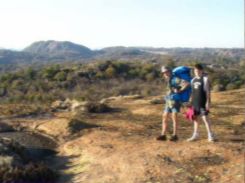 Tim and Connor on top of Shumba Shava. The hike route went past the base of Siloti Mountainin the background befored descending 80 metres to the Mtshebezi River |
This hike could be called the mud hike.
Scott Herbst
The Scout Promise of other lands
Bolivia
On my honour and with the grace of God, I promise to do all that depends on me:
To comply with the my duties to God; my country and my family;
To help my neighbour in all circumstances,
To comply faithfully with the Scout Law.
Canada
I promise to do my best
To love and serve God,
My Queen, my country and my fellow men
And to live by the Scout Law.
Japan
On my honour, I promise I will do my best
To do my duty to God/Buddha and the country,
And to obey the Scout Laws,
To help other people at all times, and
To keep myself physically strong, mentally awake and morally straight.
Nepal
On my honour I promise that I will do my best
To do my duty to my country, my King, my God/Dharma
To help other people at all times
To obey the Scout Law.
Qatar
I give my word of honour
To do my utmost to fulfil my obligations towards God and my nation
To help other people at all times
To obey the Scout Law.
Sweden
I promise
To do my best
To follow the Guide/Scout Law.
UK
On my honour I promise that I will do my best
To do my duty to God and to the Queen
To help other people And to keep the Scout Law.
USA
On my honour I will do my best
To do my duty to God and my country and
To obey the Scout Law;
To help other people at all times;
To keep myself physically strong, mentally awake and morally straight.
Zambia
On my honour I promise that I will do my best
To do my duty to God and to Zambia
To help other people and to keep the Scout Law.
To the young men of Today.
In your strong hands
The future lies today.
Hold high the torch!
Its light may help
Others on the way.
The world needs young
And steady hands
To guide it right today,
And loyal hearts
And steadfast minds:
Be it yours
To lead the way!
Success is the sum
Of small efforts
Repeated day in and day out
With never a thought
Of frustration
With never a moment of doubt.
Whatever your cherished ambition,
Begin now to make it come true,
Through efforts repeated untiring,
Put faith in the thing that you do.
1st Bulawayo (Pioneer) Scout Troop
September
2 Troop Meeting: Mabukuwene
9 - 10 Monthly Hike
11 Gordon Park Service: 12:00 noon
16 Troop Meeting: Mabukuwene
23 Troop Meeting: Mabukuwene
24 Provincial Cook-Out Completion - Milton Junior School
30 Troop Meeting: Mabukuwene
October
7 - 8 Monthly Hike
8 - 9 Parent’s Camp
9 Gordon Park Service: 12:00 noon
14 - 16 JOTA / JOTI Camp
21 Troop Meeting: Mabukuwene
28 Troop Meeting: Mabukuwene
November
4 - 5 Monthly Hike
11 Troop Meeting: Mabukuwene
13 Gordon Park Service: 12:00 noon
18 Troop Meeting: Mabukuwene
24 Schools Close
25 Troop Meeting: Mabukuwene (Sausage Sizzle)
December
2 - 4 National Patrols Completion
9 - 10 Monthly Hike
11 Gordon Park Service: 12:00 noon
16 Troop Meeting: Mabukuwene (Last meeting of the year)
25 Christmas Day
Additional Activities may be added to the Programme